Ruth E. Franklin’s “Bonnaz” Embroidery Career
Overview
Ruth E. Franklin was a mid-century chain-stitch embroiderer whose career centered on hand-operated Bonnaz machines: first in Los Angeles’s garment shops, then as owner-instructor of the Artistic Touch School of Embroidery in St. Louis.
Most of what is known about her comes from her self-published manuals and training videos, which blend autobiography with technique. Across five decades she stitched for Hollywood stars, U.S. presidents, and Major League teams, and later taught operators nationwide.
Her materials still circulate among chain-stitchers, yet little has been written about Franklin herself. This profile gathers the surviving records into a clear timeline with primary sources.
1933 - Early life and family
Missouri vital records list Ruth Esther Burge as born February 5, 1933[1], in St. Louis to O. D. Burge and Irene Chestley Kennedy. The 1940 U.S. census places her in St. Louis with six siblings; later public-records indices associate her with S. Broadway business addresses in St. Louis (1970s–1990s).
Ruth’s family:
- O. D. Burge (Father)
- Irene Chestley Kennedy (Mother)
- Chester (1913–2000),
- Annie Lee (1917–?),
- Linda Mae (1920–1997),
- Lydia Eileen (1922–2007)
- Dura Ione (1925–1986)
- Bertha Irene (1929–2008).
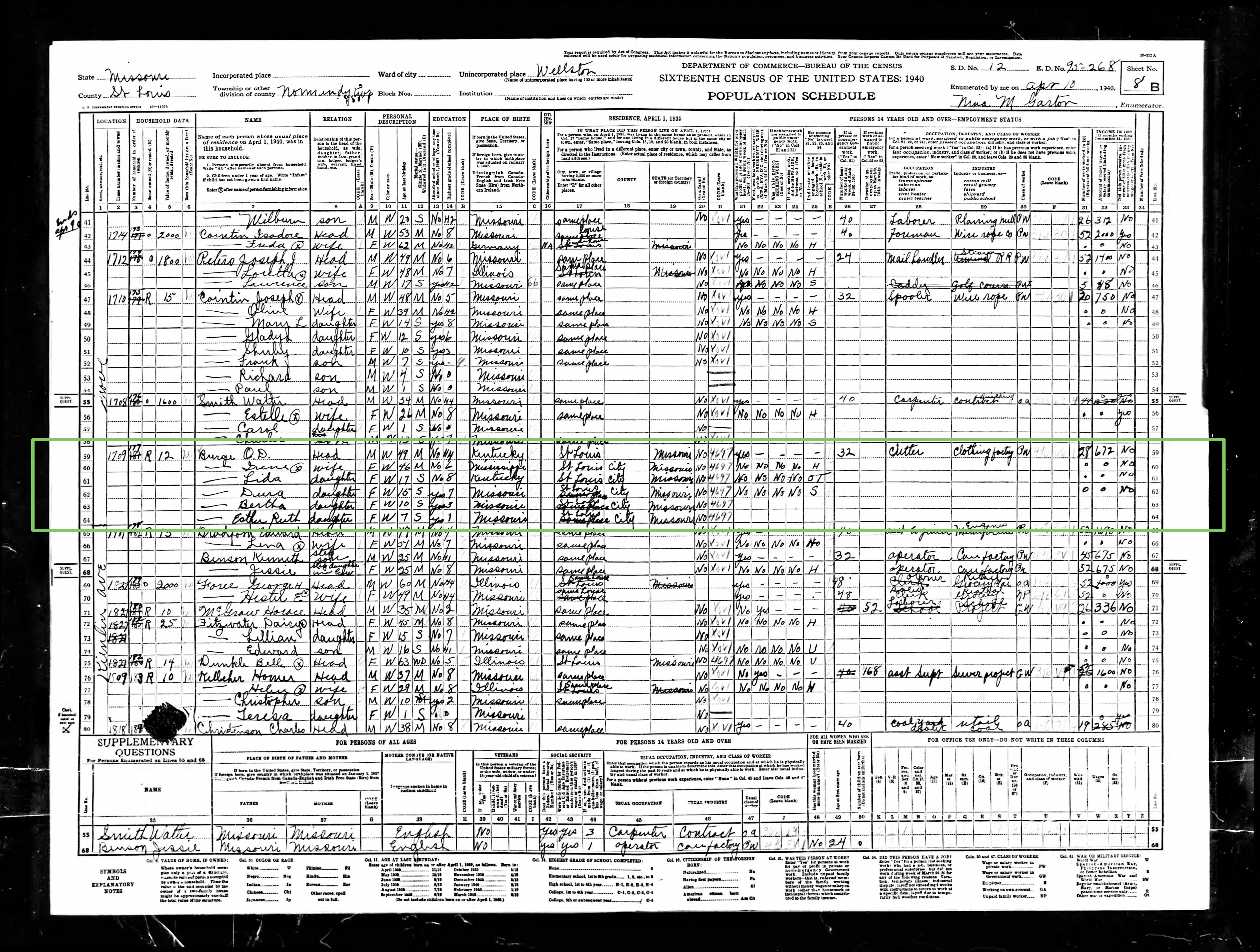
Early training and Los Angeles career (late 1940s–1960s)
In the autobiographical section of her chain-stitch training manual [p. 5] Ruth recalls visiting a sewing factory in St. Louis, Missouri (in the 1940s), where three of her sisters worked as embroidery operators. “As we went up the stairs to the shop, I was overwhelmed by a large embroidered picture of a Raven at the top of the stairs. You could see each feather and the bird looked like it could just flap its wings and fly away! …This is when I decided I wanted to learn how to do that.” [3]
By 1947, Ruth’s family had moved to Los Angeles. In one of her later business pamphlets Ruth recalls, “At that time, it wasn’t unusual for girls to quit school and go to work in sewing factories” [5]. Because most embroidery work in Los Angeles during the 1940s and 1950s was seasonal, Ruth worked at many embroidery shops. This allowed her to learn multiple embroidery styles on nearly every type of Bonnaz embroidery machine. She worked at the following LA embroidery shops:
-
Biltmore Embroidery Company: Ruth began her career in Los Angeles during the summer of 1947 at age 14. She started as a part-time thread trimmer at Biltmore Embroidery Company and soon learned to operate Bonnaz/chain-stitch machines under the tutelage of Barney Zonas and her older sister. Zonas referred to every chain-stitch machine generically as a “Bonnaz,” and Franklin credits him with instilling professionalism and respect for the equipment.
-
Barth & Dreyfuss (Royal Terry of California): After finding a “Bonnaz Operators Wanted” classified, Franklin joined Barth & Dreyfuss in Los Angeles. She writes that at this linen factory she learned to design monograms and to operate chain-stitch, cording and satin-stitch machines. She specialized in using a Cornely cording machine on hand-towels and other linens. “I worked at the towel company for several months until I could write His & Hers in my sleep.” [3]
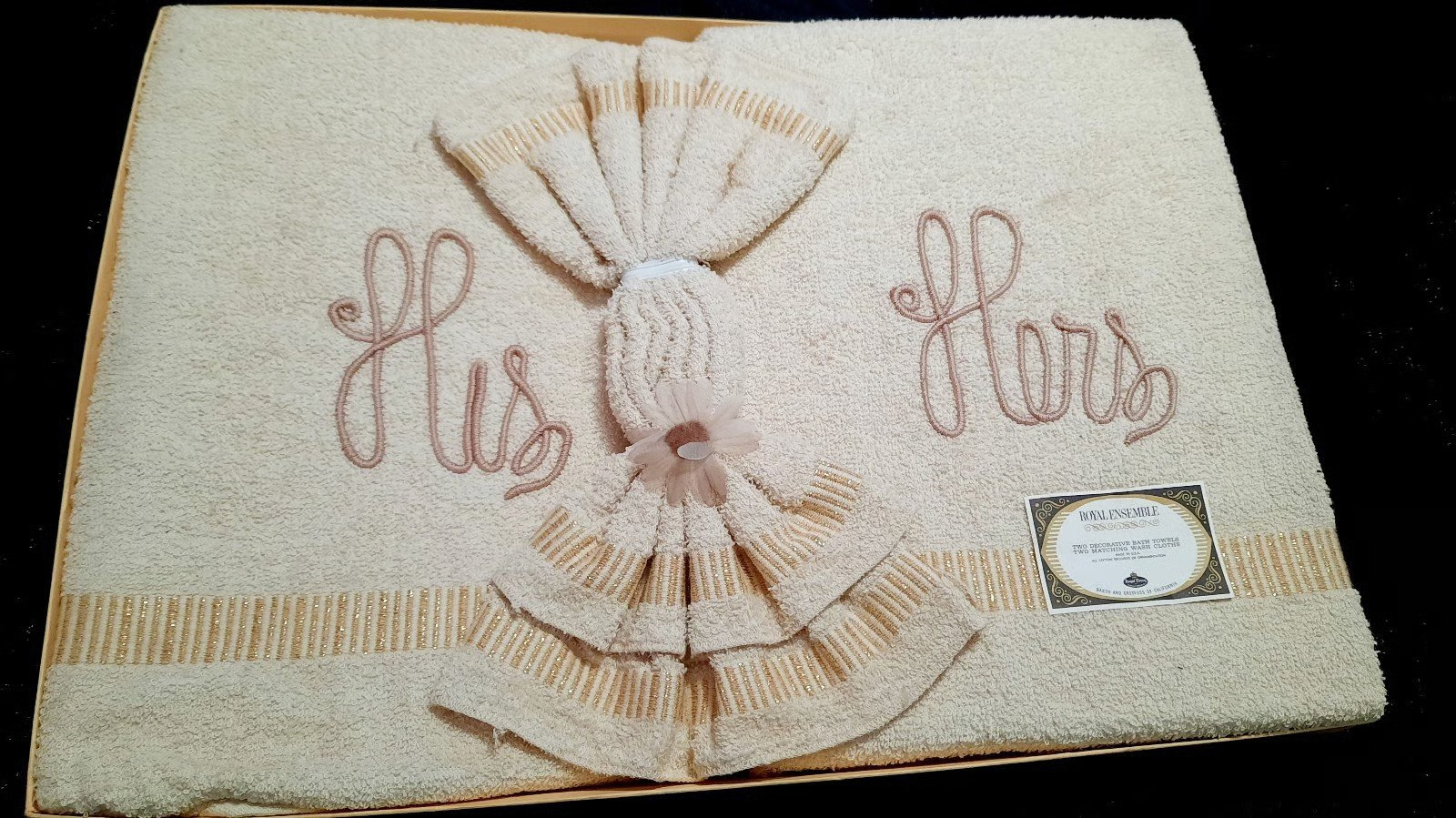
-
Perfect Embroidery Company “One day I saw another ad for “Bonnaz Operators on dress embroidery and the ad said they paid $2.00 an hour!” [3] Franklin joined Perfect Embroidery Company, owned by Joe Gutman in Los Angeles. The work was “freelance,” and she was only called to work when the company received large orders, but she was paid well.
-
Champe-Craft (Burbank): In 1953 she went to work for Bob Champe at his small lettering shop. There she learned chain-stitch lettering, chenille embroidery and screen printing [p. 6]. Champe was an excellent teacher and she noted that she learned to hand-cut film stencils for screen printing. An obituary for another embroidery operator Alice Gager similarly states that she trained at Champe-Craft in Burbank without pay until she could turn out professional work, and that the shop embroidered horse blankets for Roy Rogers and Dale Evans.
-
Olympic Emblem Company: After Champe-Craft she joined Dave Davidson, owner of Olympic Emblem Co. where she learned the specialized skill of making patches and embroidered emblems.[p. 7] During her time there, she and Davidson discovered a heat-seal process for letters by accidentally melting a plastic bag with a hot iron. This quickly became a standard method for affixing logos—such as the “LA” monogram on baseball caps, coinciding with the Dodgers’ 1958 move to Los Angeles. Little else is known about Olympic Emblem as it appears to have been a small shop that specialized in embroidered emblems and lettering rather than full-garment embroidery.
-
Nudie’s Rodeo Tailors. In 1955 Franklin also joined Nudie Cohn’s Rodeo Tailors in North Hollywood. She wrote that she created embellished outfits for stars such as Elvis Presley, Dolly Parton, Ray Price, Roy Rogers & Dale Evans, Johnny Cash, Hank Snow, Hank Williams, Rex Allen, Tex Williams and Audie Murphy [p. 7]. She even produced chain-stitch embroidery for U.S. presidents John F. Kennedy and Lyndon Johnson. Nudie never refused an order and encouraged Ruth’s creativity, telling her “Go ahead Ruth, I’ve got faith in you!” [3] Franklin later reminisced in her video transcript that she quickly learned to write Ronald Reagan’s name on her machine during his Western-film years.
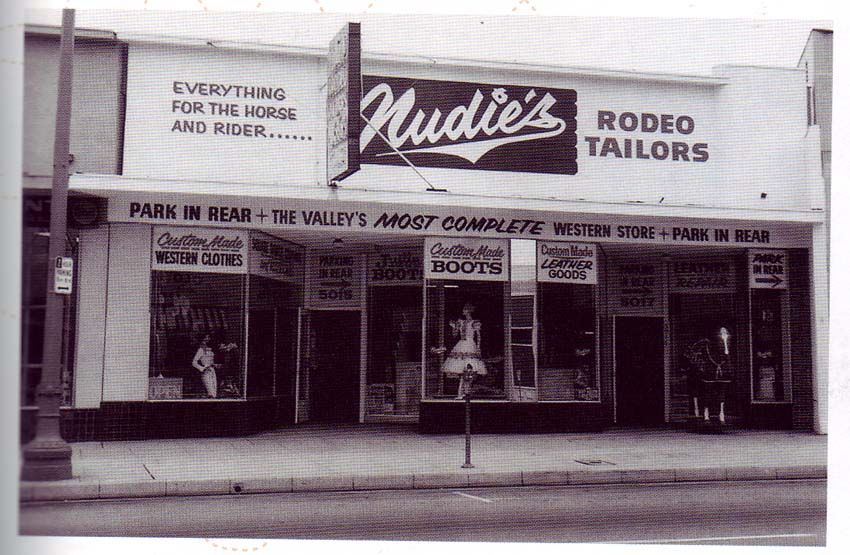
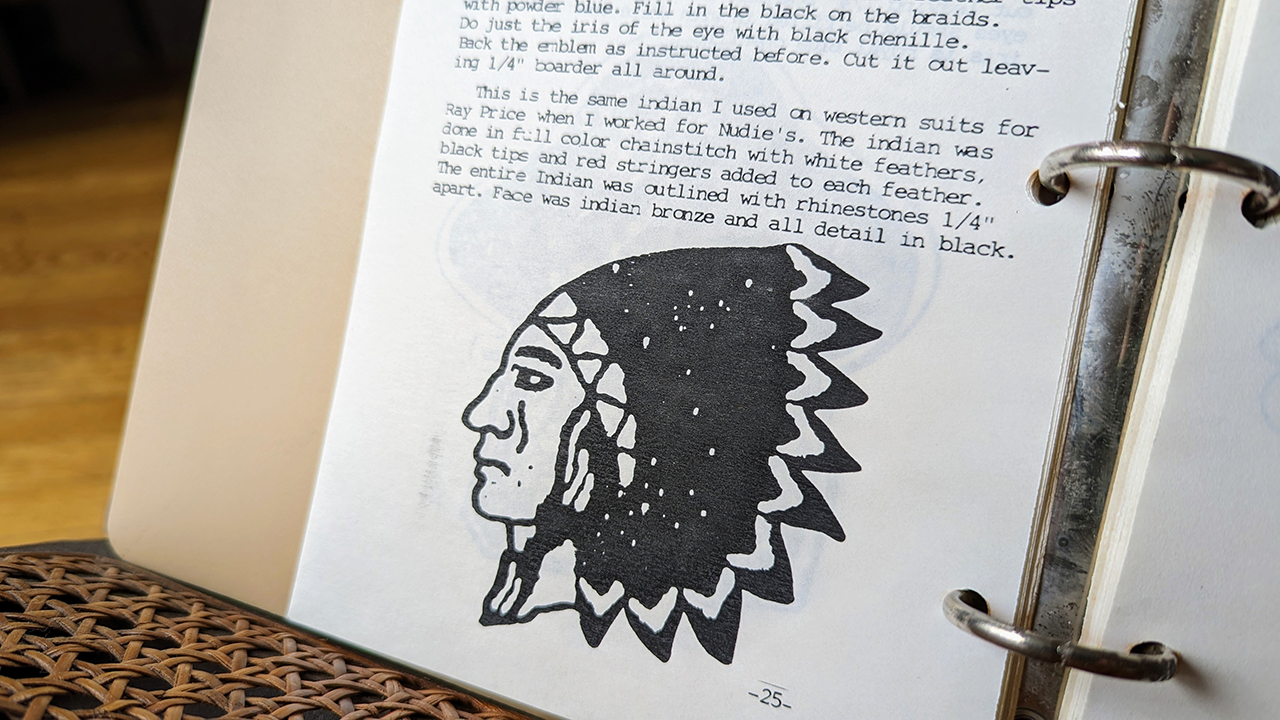
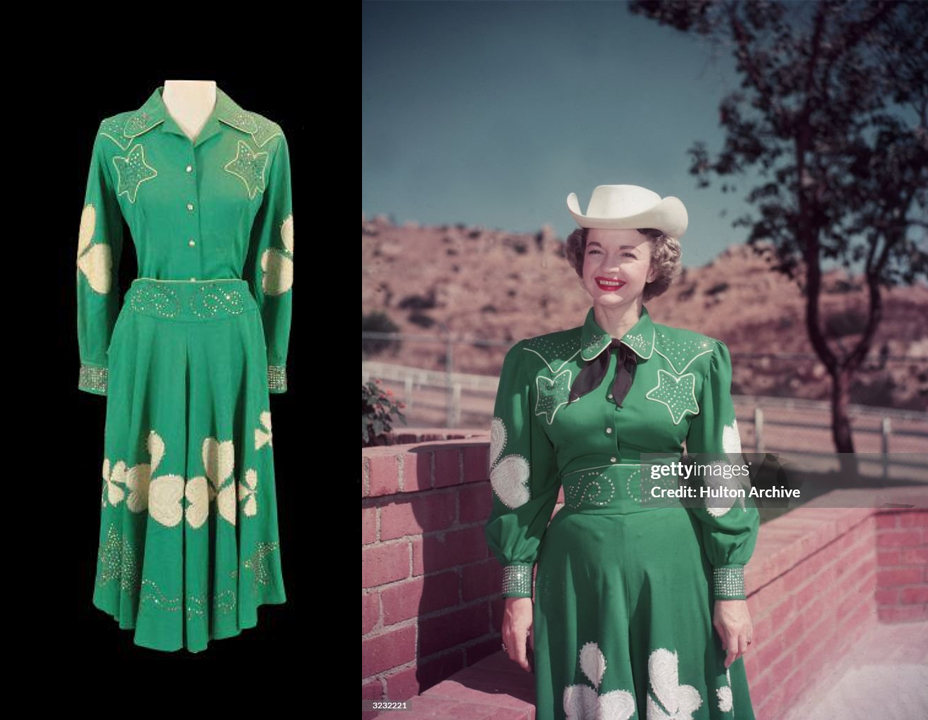
Personal life: marriages and side ventures (1950s–1960s)
In 1953 Ruth married Ben G. Franklin, the surname under which most of her career is recorded: Ruth E. Franklin.
In 1955, the Van Nuys News (Feb 10) shows that Ruth and Ben registered for an occupational business license at the address 7006 Foothill Blvd. It’s unclear what this business was, but by 1965 Ruth owned a dog grooming business named “Tessamablu Poodles.” Bonnie Williams recalls “She was in the pet grooming business for a while and specialized in Poodle cuts. She was in a partnership with a guy…they had a falling out and that was the end of that.” The business was listed at 13515 Van Nuys Blvd and then moved to 12057 Strathern, North Hollywood by 1965.
The 1966-1984 California divorce index and Nevada Marriage Index (1855-1985) shows that Ruth and Ben may have remarried in Carson City, Nevada on Apr 13, 1966 after splitting up for a year but ultimately divorced in Los Angeles in August of 1967.

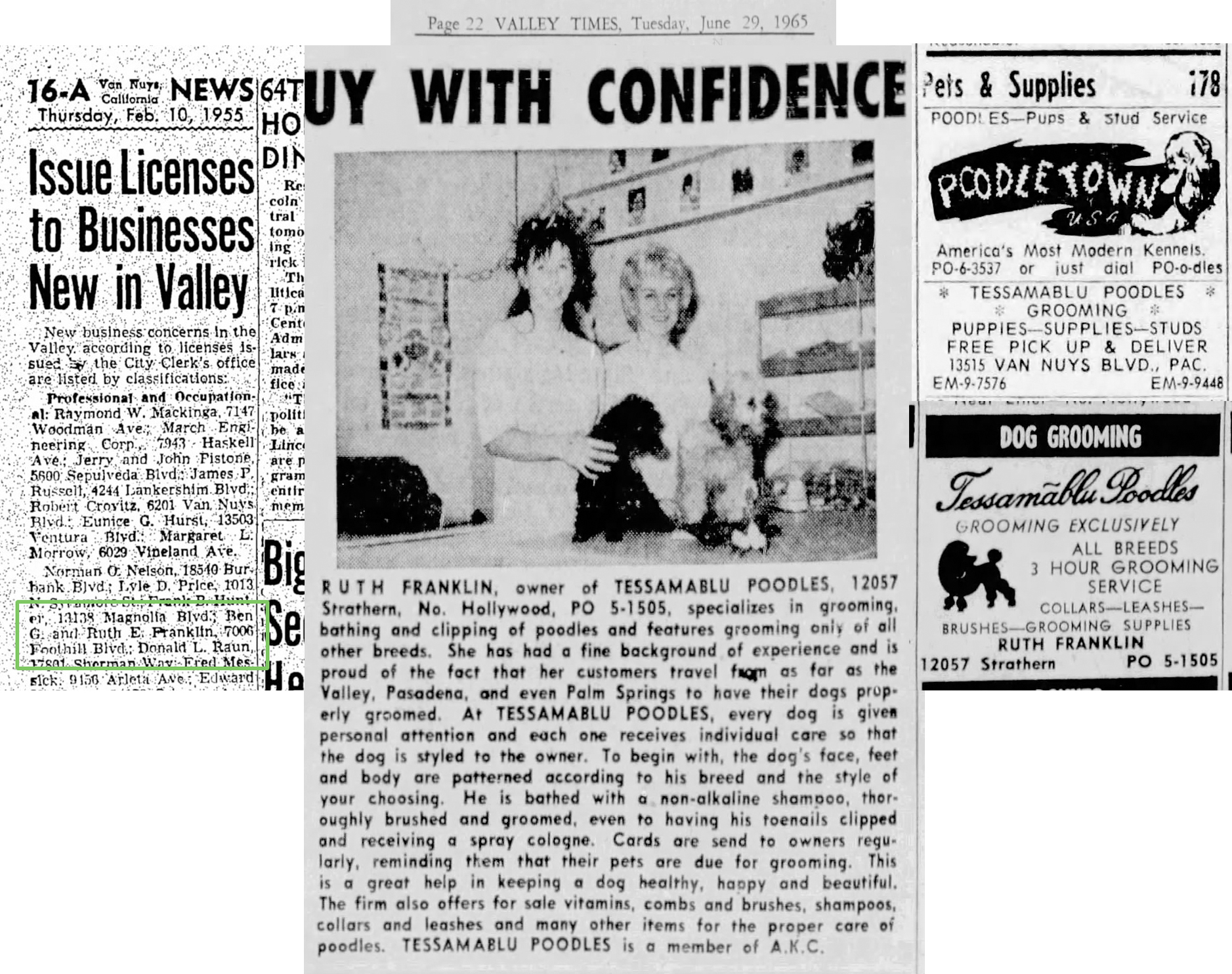
Return to St. Louis and Artistic Touch Embroidery (1970s–1990s)
After more than two decades on the West Coast, Franklin returned to her hometown; she writes that she moved back to St. Louis in 1969 [p. 8]. There she worked for several embroidery shops before finally opening her own. “I thought I had paid my dues in the embroidery business working for Barney, Bob, Dave & Nudie, but I found I still had a lot more to learn when I opened my shop!” [3]
Franklin opened “Artistic Touch Embroidery & Monogramming” in 1974 at 8818 Manchester Rd. She specialized in lettering, monogramming, silk-screening, and hand application of rhinestones and sequins, while she continued working with Nudie’s Rodeo Tailors.
According to a newspaper article in the St. Louis Post-Dispatch (June 14, 1983) Ruth said “I specialize in the off-beat.” [7]
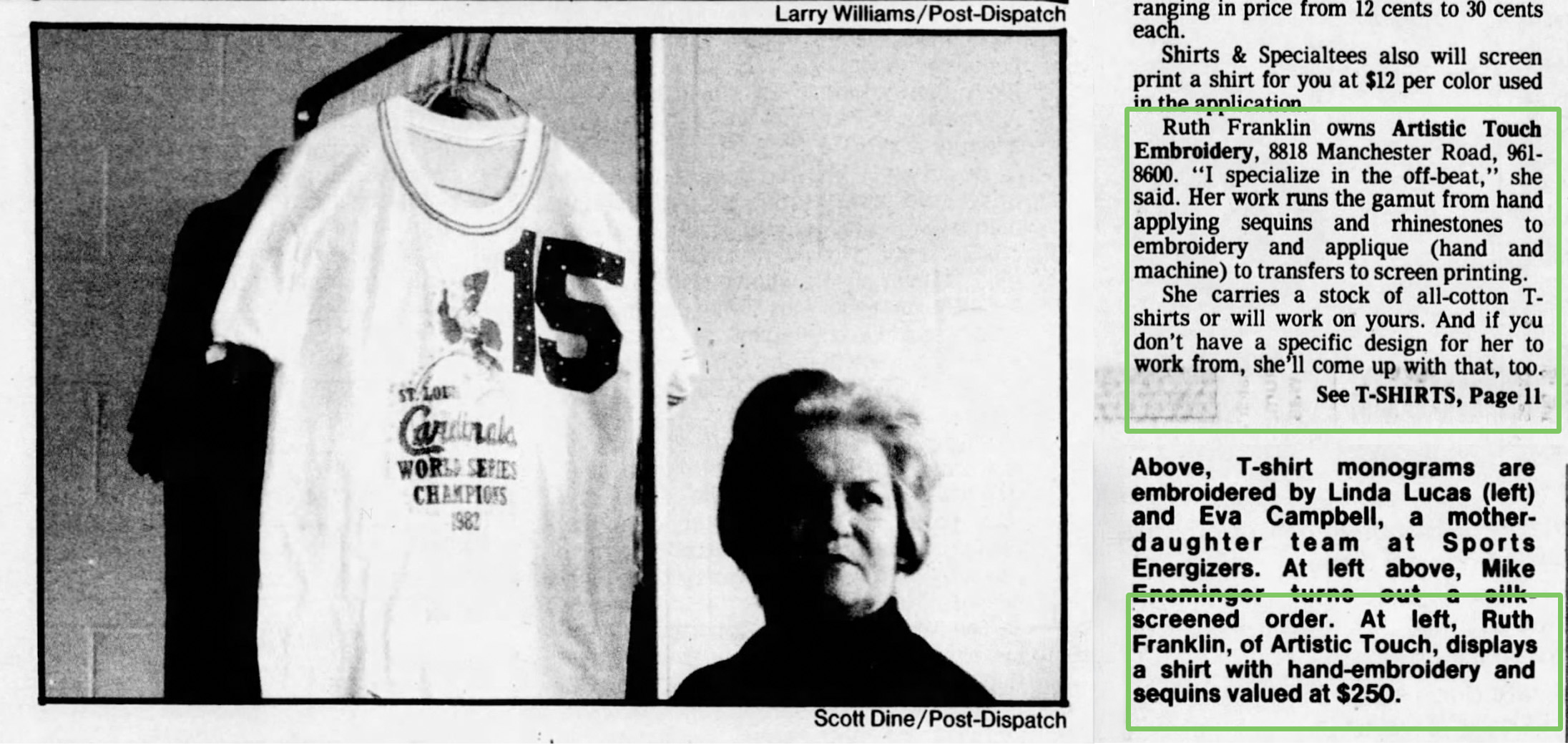

Artistic Touch on Broadway Ave.
Mail-order forms and advertisements list 9724 S. Broadway, St. Louis, MO 63125. A revised order form date-stamped March 1991 still uses this address, indicating that 9724 was the primary location of Artistic Touch throughout the 80s.
Former student Bonnie Williams recalled her workshop in 1987-88: “While she was still in St. Louis, she had a building where the main floor was where all of her machines were, along with a kitchen area and a small bedroom. The basement was where she had her screen printing equipment … there was a second story that had two bedrooms and a bathroom - that is where my husband and I stayed when we went there for the five-day class. Ruth slept in the small room on the main level.
A 1992–93 Artistic Touch price list for athletic supplies notes a mailing address three blocks down S. Broadway, listing the business at 9534 S. Broadway, St. Louis, MO 63125, and advertising “over forty-five years in the embroidery business.” [6]
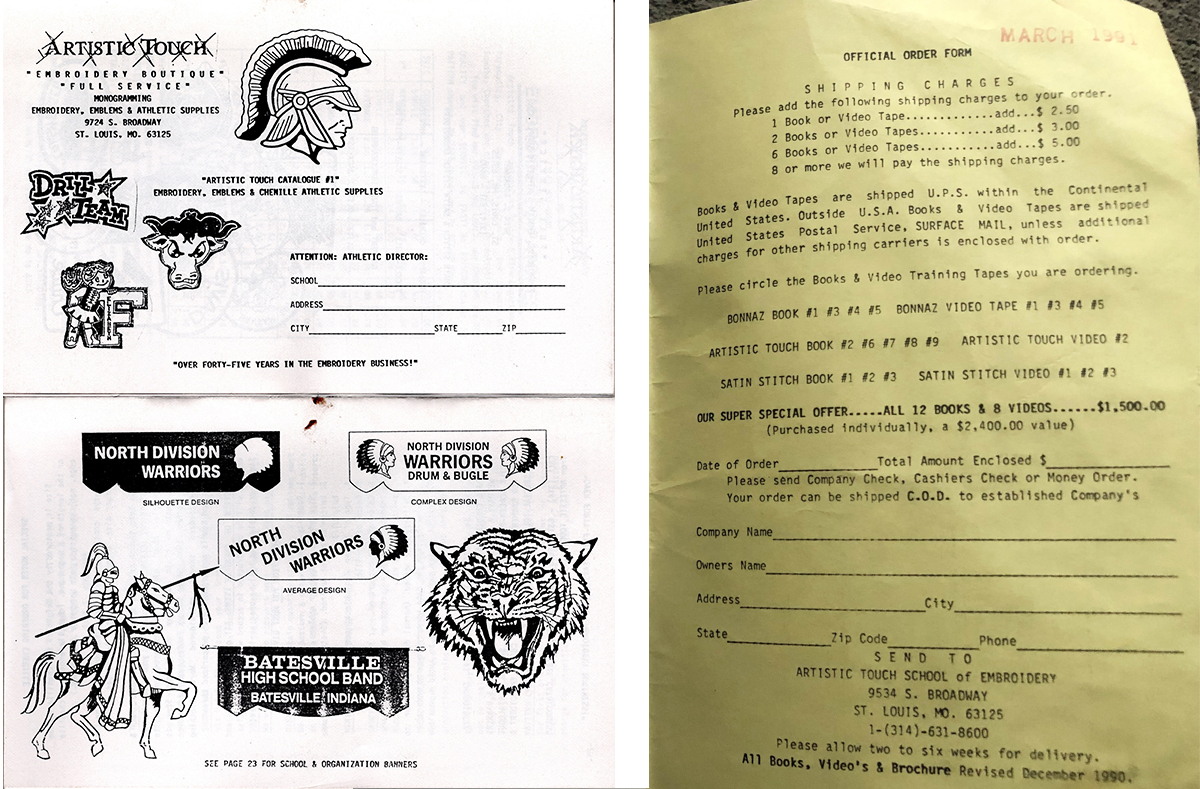
Addresses & Listings
| Year / Source | Address | Notes |
|---|---|---|
| 1974-late 1970s (first business listing) | 8818 Manchester Rd, St Louis | Early location noted in classifieds |
| Late 1970s–1980s (manuals) | 9724 S. Broadway, St. Louis | Main shop and school address |
| 1986-1988 (manuals) | 9908 S. Broadway, St. Louis | Artistic Touch mailing address |
| 1990s- (forms & cording manual) | 9534 S. Broadway, St. Louis | Last known mailing address |
Late 1980s-early 1990s - Artistic Touch School of Embroidery
Initially a commercial embroidery shop, Artistic Touch quickly became a “teaching studio” because “people came from all over the United States to learn” and she “ended up teaching her competitors.” Ruth talked about how embroidery shops all across the United States would call her up, asking for instruction. “I was surprised and delighted, to receive calls & letters from people who had been in the business for many years!” [5]
Following a 1985 heart attack Franklin began documenting her career and the Bonnaz embroidery skillset. “This made me realize I was one of the few “old timers” still around with enough knowledge about all of the machines. … While I was recuperating from my heart attack, I decided THE TIME HAD COME FOR ME TO WRITE THAT BOOK.” [5]
Franklin went on to self-publish a suite of manuals and VHS instructionals under the imprint Artistic Touch Publications. Each book combines historical context, machine diagrams, step-by-step instructions, pricing advice and business tips. You can find the majority of her publications on this website for free. These manuals were sold individually or as a set via mail-order; price lists note that each book or video cost $49.95 (about $125 today). Franklin also offered personal training in St. Louis; she lists weeklong classes at $500.

Former student Bonnie Williams recalled an intensive on-site training with Franklin in 1987. “When I was with Ruth Franklin she made me completely disassemble a machine and put it back together. She made me do squares for about an hour one day until I got my corners sharp. …many referred to her as a “Crusty old Fart” but she was great. She didn’t hesitate to let ya know if you weren’t doing something perfectly”
She noted that her books were vetted by former employers and specifically by Christine DeChamp of the Cornely Company. [p. 10] She stated that chain-stitch machines would never be replaced for true embroidery artisans and dedicated her book on cording and braid to the Cornely Company of Malakoff, France, thanking the company for producing the machines that provided her with a trade for over forty years.

Ruth continued to commercialize her skills through magazine advertisements[2], mailed booklets and catalogs through the early 1990s. Advertising her school of embroidery alongside a commercial embroidery business offering lettering for business uniforms, bowling shirts and jackets. She also advertised garment and towel monogramming, flags, banners and silk-screen printing.
1993 Mississippi River flood
In August of 1993 the Mississippi River overtopped its banks in St. Louis, producing what the National Weather Service called the costliest and most devastating flood in modern U.S. history. The river crested at 49.58 feet at St. Louis on August 1, 1993, nearly 20 feet above flood stage, stressing levees and threatening low-lying neighborhoods.
Ruth had relocated to Arkansas and moved her machines out of the South Broadway shop shortly before the flood occurred. According to Williams, Ruth believed that her decision to move came at the right time for a reason. “She took it as instructions from the Almighty,” Bonnie explained, noting that Ruth told her “God knew that I would not be able to stand it to see my life’s work and machines under water.”
Contemporary news reports show that the flooding reached the South Broadway/Lemay corridor where Franklin’s shop had previously been located. A timeline compiled by the Riverfront Times reports that on August 2, 1993, residents around the Phillips Pipeline Company on South Broadway were ordered to evacuate when floodwaters inundated the tank yard. St. Louis Public Radio later recalled 2,500 city residents and 9,000 county residents were evacuated.

Death and final years in Conway, Arkansas
Ruth spent her final years in Conway, Arkansas in proximity to a niece who she had been close to. The Log Cabin Democrat (a daily newspaper serving Conway and Faulkner County) reports that she was hospitalized in 1994 and in 1996.
In 1995 The Log Cabin Democrat also reports that Ruth had outstanding Yellow Pages charges advertising her business “Artistic Touch.”
The Social Security Death Index gives her last residence as Conway, Arkansas and records her death on November 29, 1997.
Bonnie Williams recalled “We talked often and she (Ruth) told me that she had given instructions to her niece to be sure to call me if anything happened to her. In 1996 when I realized that I hadn’t talked to her for a while I tried to call her and her phone was not in use and I couldn’t get any information on the niece but that told me that she passed away. The niece never ever contacted me.”
Unfortunately, an obituary or probate notice has yet been located.
Legacy and remaining gaps
Ruth E. Franklin’s publications and teaching preserved knowledge of “Bonnaz” chain-stitch embroidery machines at a time when few others documented the craft. Her manuals blend technical diagrams, maintenance tips, pattern stamping, monogram alphabets and business advice, revealing her depth of experience. Her dedication to Bonnaz machines and declaration that “chain-stitch machines will never be replaced” [3] demonstrate her belief in the artistic value of hand-operated embroidery, even in the era of computerized embroidery.
Despite the information above, significant questions remain:
-
Family and private life. Public-record databases confirm that Franklin was born Ruth Esther Burge in 1933 and later used the surnames “Hill”, “Davis”, “Dunbar” and “Franklin” reflecting at least three marriages.
According to the 1949-1959 California Marriage Index, Ruth married Jack Dunbar on June 10, 1950, a few years before marrying Ben G. Franklin; no divorce record for Dunbar has been located. Los Angeles divorce records also show a marriage to Alexander Lavar Hill on January 14, 1950; the listed ages imply a 1931 birth year, likely a different Ruth E. Burge. The surnames “Hill” and “Davis” appear in Social Security files without corroborating documents so far.
-
Arkansas relocation and final years Information on the niece that Ruth went to live with is still unclear. The majority of her immediate family seems to have passed away, making further investigation difficult. No independent obituaries or news articles have yet surfaced that would list her family members or confirm her marital history.
-
Post Flood: Artistic Touch While early drafts of this article suggested that Ruth’s shop was destroyed in the Great Flood of 1993, later clarification from Bonnie Williams confirms that Ruth had already relocated to Arkansas and moved her machines out before the flood occurred. The South Broadway area was indeed inundated, but Franklin’s equipment and business property were not lost. The ultimate fate of her machines and other materials after the move, however, remains unknown.
Conclusion
Ruth E. Franklin emerges from these documents as a pioneering chain-stitch embroiderer and driven entrepreneur. Her early work in Los Angeles with mentors like Barney Zonas and Christine DeChamp of the Cornely Company, her high-profile years at Nudie’s Rodeo Tailors and her return to Missouri to run the Artistic Touch School of Embroidery illustrate a career devoted to preserving and teaching hand-operated embroidery. The surviving manuals, price lists and video transcripts provide concrete evidence of her methods and business operations. While some personal life details remain obscure, Franklin’s legacy lives on in the skillset she championed and the instructional materials that continue to educate new generations of chain-stitch artists.
Timeline at a glance
- 1933 — Born Ruth Esther Burge in St. Louis, Missouri.
- 1947 — Moves to Los Angeles; starts in embroidery shops as a teen; trains on Bonnaz/chain-stitch machines.
- 1950–1953 — Early marriages; by 1953 married to Ben G. Franklin (later divorces in 1967).
- 1953–1958 — Trains/works at Champe-Craft, Olympic Emblem Co.
- 1955 — Works at Nudie’s Rodeo Tailors; outfits for recording and film stars.
- 1965 — Operates “Tessamablu Poodles” (Van Nuys / North Hollywood).
- 1967 — Divorces Ben G. Franklin in Los Angeles.
- 1969 — Returns to St. Louis.
- 1974 — Opens Artistic Touch Embroidery & Monogramming.
- 1985 — Heart attack; begins writing the manuals and producing training videos.
- 1993 — Relocates to Conway, Arkansas. Great Flood submerges the South Broadway area.
- 1997 — Dies in Conway (Nov 29), per Social Security Death Index.
Sources
- 1: Missouri Secretary of State Archives — Birth and Vital Records
- 2: Threads Magazine, Aug/Sept 1989 (Vol. 24).
- 3: Ruth E. Franklin, Chain-Stitch Training Manual, pp. 5–10.
- 4: Ruth E. Franklin, Artistic Touch School of Bonnaz Embroidery, Vol. 1 Transcript.
- 5: Ruth E. Franklin, Artistic Touch School of Embroidery, Embroidery News, March 1991 (image scan)
- 6: Ruth E. Franklin, Artistic Touch Catalogue #1 1992-1993 (image scan)
- 7: St. Louis Post-Dispatch, June 14, 1983. (image scan): /images/St_Louis_Post_Dispatch_1983_06_14_Page_22-23.jpg
- 8: 1940 U.S. Census — St. Louis (image scan): /images/1940_US_Census.jpg
- 9: Van Nuys News, Feb 10, 1955. (image scan): /images/The_Van_Nuys_News_1955_02_10_Page_17_BenGFranklinAndRuthBusinessHL.jpg
- 10: Valley Times, June 29, 1965. (image scan): /images/Valley_Times_1965_06_29_22_Ruth_Frankin_owner_of_Tessamablu_Poodles.jpg
- 11: Log Cabin Democrat (Conway, AR), 1994–1996 issues.
- 1994-09-01 — /images/The_Log_Cabin_Democrat_1994_09_01_9_Hospital_HL.jpg
- 1995-06-15 — /images/The_Log_Cabin_Democrat_1995_06_15_RuthLawsuitHL.jpg
- 1996-03-13 — /images/The_Log_Cabin_Democrat_1996_03_13_5_HospitalHL.jpg
- 12: Riverfront Times, “How the Great Flood of 1993 Deluged St. Louis.”
- 13: National Weather Service “The Great Flood of 1993”
- 14: U.S. Social Security Death Index (1997, Conway, AR).
- 15: California Marriage/Divorce Indexes and Nevada Marriage Index (1949–1985).
- /images/CalMarriage1949.jpg
- /images/CalDivorce1966.jpg
- 16: Obituary, Alice Gager — Garden City Funeral Home, Missoula MT.
If you have additional information about the life or legacy of Ruth E. Franklin (Burge), please contact me at noah@stitch-rite.com
Update 10/09/25
Additional correspondence with Bonnie Williams, former student and friend of Ruth Franklin, has clarified the timeline surrounding Franklin’s move to Arkansas and the 1993 Mississippi River flood.
Ruth Franklin had already relocated to Arkansas before the flood and had moved out of her shop on South Broadway prior to the disaster. While the surrounding area was heavily affected, Bonnie Williams confirms that Ruth’s business itself was not directly damaged by floodwaters, though it remains unclear what became of her embroidery machines and other shop contents.